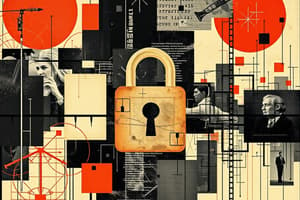Podcast
Questions and Answers
Which of the following is an example of a technical security control?
Which of the following is an example of a technical security control?
- User access reviews
- Vulnerability management
- Periodic risk assessments
- Firewall rules (correct)
What category do firewalls and encryption belong to?
What category do firewalls and encryption belong to?
- Operational controls
- Technical controls (correct)
- Corrective controls
- Managerial controls
Which of the following control types is specifically designed to remediate security issues that have already occurred?
Which of the following control types is specifically designed to remediate security issues that have already occurred?
- Preventive controls
- Corrective controls (correct)
- Detective controls
- Deterrent controls
Which of the following is not a characteristic of operational controls?
Which of the following is not a characteristic of operational controls?
What is the primary purpose of deterrent controls?
What is the primary purpose of deterrent controls?
Which of the following examples is classified as a physical control?
Which of the following examples is classified as a physical control?
Which type of control includes mechanisms like intrusion detection systems?
Which type of control includes mechanisms like intrusion detection systems?
Which of the following best describes managerial controls?
Which of the following best describes managerial controls?
Which of the following scenarios best illustrates a preventive control?
Which of the following scenarios best illustrates a preventive control?
Which of the following options does not represent a form of corrective control?
Which of the following options does not represent a form of corrective control?
Examples of technical security controls include firewall rules, access control lists, and ______.
Examples of technical security controls include firewall rules, access control lists, and ______.
Operational controls include user access reviews, log monitoring, and ______ management.
Operational controls include user access reviews, log monitoring, and ______ management.
Managerial controls focus on the mechanics of the ______ management process.
Managerial controls focus on the mechanics of the ______ management process.
Examples of physical security controls include fences, perimeter lighting, locks, and ______ suppression systems.
Examples of physical security controls include fences, perimeter lighting, locks, and ______ suppression systems.
Preventive controls intend to stop a security issue before it ______.
Preventive controls intend to stop a security issue before it ______.
Deterrent controls seek to prevent an attacker from attempting to violate security ______.
Deterrent controls seek to prevent an attacker from attempting to violate security ______.
Detective controls identify security events that have already ______.
Detective controls identify security events that have already ______.
Corrective controls remediate security issues that have already ______.
Corrective controls remediate security issues that have already ______.
Vicious guard dogs and barbed wire fences are examples of ______ controls.
Vicious guard dogs and barbed wire fences are examples of ______ controls.
Explain the role of technical controls in information security.
Explain the role of technical controls in information security.
What distinguishes operational controls from other security control categories?
What distinguishes operational controls from other security control categories?
Describe the difference between preventive and detective controls.
Describe the difference between preventive and detective controls.
Identify a key characteristic of managerial controls and provide an example.
Identify a key characteristic of managerial controls and provide an example.
What is the purpose of physical controls in a security framework?
What is the purpose of physical controls in a security framework?
What is the primary focus of integrity controls in cybersecurity?
What is the primary focus of integrity controls in cybersecurity?
Which control mechanisms are primarily aimed at ensuring availability in information systems?
Which control mechanisms are primarily aimed at ensuring availability in information systems?
Which of the following factors may threaten both integrity and availability controls?
Which of the following factors may threaten both integrity and availability controls?
What is a common goal of attackers concerning confidentiality?
What is a common goal of attackers concerning confidentiality?
Which of the following best describes the purpose of access control lists?
Which of the following best describes the purpose of access control lists?
Study Notes
Security Control Categories
- Security controls are categorized by their mechanism of action.
- Four categories of security controls exist: technical, operational, managerial, and physical.
Technical Controls
- Enforce confidentiality, integrity, and availability in digital spaces.
- Examples include:
- Firewall rules: Manage network traffic.
- Access control lists: Define user permissions and access.
- Intrusion prevention systems: Detect and prevent potential threats.
- Encryption: Protects data by converting it into coded format.
Operational Controls
- Focus on processes for managing technology securely.
- Examples include:
- User access reviews: Assess and validate user permissions.
- Log monitoring: Track and analyze system logs for suspicious activity.
- Vulnerability management: Identify and remediate weaknesses in systems.
Managerial Controls
- Procedural mechanisms concentrating on risk management processes.
- Examples include:
- Periodic risk assessments: Evaluate risks and vulnerabilities regularly.
- Security planning exercises: Prepare strategies for security enhancement.
- Incorporation of security into change management: Ensure security is considered in all organizational changes.
Physical Controls
- Impact the physical security of facilities and assets.
- Examples include:
- Fences: Provide perimeter security.
- Perimeter lighting: Deters unauthorized access through visibility.
- Locks: Secure access to buildings and rooms.
- Fire suppression systems: Protect facilities from fire hazards.
- Burglar alarms: Alert to unauthorized entry.
Security Control Types
- Security controls can also be classified by their desired effect.
Preventive Controls
- Aim to stop security issues before they occur.
- Examples include:
- Firewalls: Block unauthorized access.
- Encryption: Prevent unauthorized data access during transmission.
Deterrent Controls
- Seek to discourage attackers from attempting to breach security.
- Examples include:
- Guard dogs: Deter intruders through presence.
- Barbed wire fences: Physically obstruct entry.
Detective Controls
- Identify security events that have already taken place.
- Example:
- Intrusion detection systems: Monitor networks for suspicious activities.
Corrective Controls
- Address and remediate security issues post-incident.
- Example:
- Restoring backups: Recover data after a ransomware attack.
Compensating Controls
- Mitigate risks associated with exceptions to security policies.
Directive Controls
- Inform employees and stakeholders on security protocols.
- Examples include:
- Policies and procedures: Provide guidelines to achieve security objectives.
Security Control Categories
- Security controls are categorized by their mechanism of action.
- Four categories of security controls exist: technical, operational, managerial, and physical.
Technical Controls
- Enforce confidentiality, integrity, and availability in digital spaces.
- Examples include:
- Firewall rules: Manage network traffic.
- Access control lists: Define user permissions and access.
- Intrusion prevention systems: Detect and prevent potential threats.
- Encryption: Protects data by converting it into coded format.
Operational Controls
- Focus on processes for managing technology securely.
- Examples include:
- User access reviews: Assess and validate user permissions.
- Log monitoring: Track and analyze system logs for suspicious activity.
- Vulnerability management: Identify and remediate weaknesses in systems.
Managerial Controls
- Procedural mechanisms concentrating on risk management processes.
- Examples include:
- Periodic risk assessments: Evaluate risks and vulnerabilities regularly.
- Security planning exercises: Prepare strategies for security enhancement.
- Incorporation of security into change management: Ensure security is considered in all organizational changes.
Physical Controls
- Impact the physical security of facilities and assets.
- Examples include:
- Fences: Provide perimeter security.
- Perimeter lighting: Deters unauthorized access through visibility.
- Locks: Secure access to buildings and rooms.
- Fire suppression systems: Protect facilities from fire hazards.
- Burglar alarms: Alert to unauthorized entry.
Security Control Types
- Security controls can also be classified by their desired effect.
Preventive Controls
- Aim to stop security issues before they occur.
- Examples include:
- Firewalls: Block unauthorized access.
- Encryption: Prevent unauthorized data access during transmission.
Deterrent Controls
- Seek to discourage attackers from attempting to breach security.
- Examples include:
- Guard dogs: Deter intruders through presence.
- Barbed wire fences: Physically obstruct entry.
Detective Controls
- Identify security events that have already taken place.
- Example:
- Intrusion detection systems: Monitor networks for suspicious activities.
Corrective Controls
- Address and remediate security issues post-incident.
- Example:
- Restoring backups: Recover data after a ransomware attack.
Compensating Controls
- Mitigate risks associated with exceptions to security policies.
Directive Controls
- Inform employees and stakeholders on security protocols.
- Examples include:
- Policies and procedures: Provide guidelines to achieve security objectives.
Security Control Categories
- Security controls are categorized by their mechanism of action.
- Four categories of security controls exist: technical, operational, managerial, and physical.
Technical Controls
- Enforce confidentiality, integrity, and availability in digital spaces.
- Examples include:
- Firewall rules: Manage network traffic.
- Access control lists: Define user permissions and access.
- Intrusion prevention systems: Detect and prevent potential threats.
- Encryption: Protects data by converting it into coded format.
Operational Controls
- Focus on processes for managing technology securely.
- Examples include:
- User access reviews: Assess and validate user permissions.
- Log monitoring: Track and analyze system logs for suspicious activity.
- Vulnerability management: Identify and remediate weaknesses in systems.
Managerial Controls
- Procedural mechanisms concentrating on risk management processes.
- Examples include:
- Periodic risk assessments: Evaluate risks and vulnerabilities regularly.
- Security planning exercises: Prepare strategies for security enhancement.
- Incorporation of security into change management: Ensure security is considered in all organizational changes.
Physical Controls
- Impact the physical security of facilities and assets.
- Examples include:
- Fences: Provide perimeter security.
- Perimeter lighting: Deters unauthorized access through visibility.
- Locks: Secure access to buildings and rooms.
- Fire suppression systems: Protect facilities from fire hazards.
- Burglar alarms: Alert to unauthorized entry.
Security Control Types
- Security controls can also be classified by their desired effect.
Preventive Controls
- Aim to stop security issues before they occur.
- Examples include:
- Firewalls: Block unauthorized access.
- Encryption: Prevent unauthorized data access during transmission.
Deterrent Controls
- Seek to discourage attackers from attempting to breach security.
- Examples include:
- Guard dogs: Deter intruders through presence.
- Barbed wire fences: Physically obstruct entry.
Detective Controls
- Identify security events that have already taken place.
- Example:
- Intrusion detection systems: Monitor networks for suspicious activities.
Corrective Controls
- Address and remediate security issues post-incident.
- Example:
- Restoring backups: Recover data after a ransomware attack.
Compensating Controls
- Mitigate risks associated with exceptions to security policies.
Directive Controls
- Inform employees and stakeholders on security protocols.
- Examples include:
- Policies and procedures: Provide guidelines to achieve security objectives.
Confidentiality
- Protects sensitive information from unauthorized access.
- Cybersecurity professionals implement tools like firewalls, access control lists, and encryption to strengthen confidentiality.
- Attackers may target confidentiality controls to disclose sensitive information without permission.
Integrity
- Ensures information and systems are not modified without authorization, whether maliciously or accidentally.
- Integrity is enforced through measures like hashing and integrity monitoring solutions.
- Threats to integrity can arise from attackers wanting to change data or from nonmalicious causes like power surges leading to data corruption.
Availability
- Guarantees that legitimate users can access information and systems when needed.
- Availability is supported by fault tolerance, clustering, and data backups.
- Threats to availability can stem from malicious attacks aiming to disrupt services or from accidental incidents like fires damaging data centers.
Studying That Suits You
Use AI to generate personalized quizzes and flashcards to suit your learning preferences.
Description
Test your knowledge on the different categories of security controls, including technical, operational, managerial, and physical controls. This quiz covers definitions, examples, and the importance of each control type in maintaining security.




